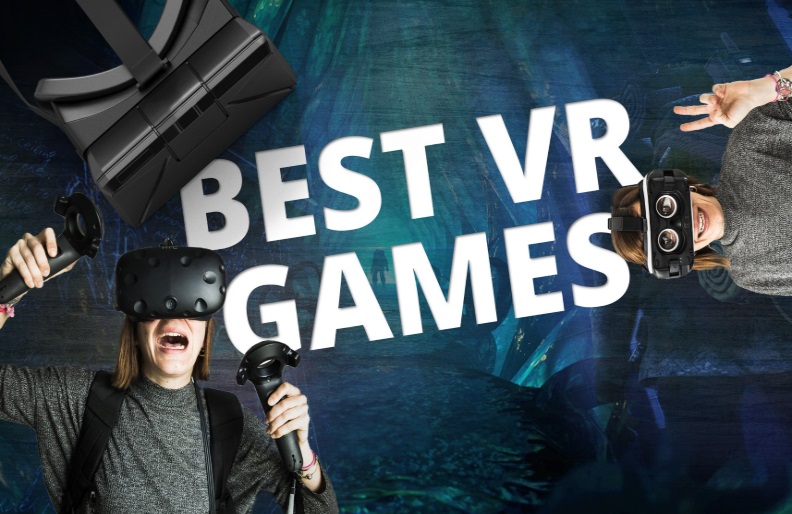It’s been two years since consumers officially got their hands on virtual reality with the HTC Vive and Oculus Rift, and in that time a lot of VR games have released. Sure, there may still be no singular headset-seller, but trawl Steam or the Oculus Store and you’ll still find hundreds of hours of entertainment—some of it pretty good!
So where to start? Well, we compiled a list of our favorite Oculus Rift games and our favorite HTC Vive games back in 2016, and some of those (Job Simulator, Tilt Brush, Chronos) are still worth checking out. The Vive Pro’s recent release is a handy excuse for an update though, and below you’ll find an additional (meaning no repeats from the earlier lists) batch of VR games to jumpstart your collection. Note: Some games are exclusive to one platform or the other, and these have been marked where appropriate.
Of course, you’ll need a modern VR headset to experience these. The games and experiences on this list are a mix of games for Oculus Rift and HTC Vive.
Skyrim VR and Fallout 4 VR (Vive)
Neither of Bethesda’s ports are amazing made-for-VR experiences. They’re full of control issues, unintuitive interfaces, and other annoyances emblematic of games ported to VR after the fact instead of built for it from the start.
Again, they’re far from perfect—but until VR catches on, these half-baked ports are probably the best we can hope for, at least when it comes to having a “traditional” gaming experience.
The Gallery – Episode 2: Heart of the Emberstone
The Gallery is the closest we’ll come to a repeat entry from our original Vive/Rift recommendations. The game’s first episode, Call of the Starseed, was one of the Vive’s standout launch titles. A combination of Myst-like mechanical puzzles with a larger-than-life science fiction story, it was a perfect early example of what VR could do for adventure games.
Kingspray and ViveSpray
Rule one of VR: For any Oculus Rift exclusive, there is an equal and opposite Vive version. Okay, not all the time, but it happens surprisingly often.
Kingspray Graffiti and ViveSpray are the first ones I remember. Kingspray, a promising graffiti-sim, announced a few months after its debut trailer that it’d actually be an Oculus exclusive. The outcry from the Vive community was immediate, and led to someone throwing together ViveSpray—a rough-edged equivalent.
Google Earth VR
No game has held my interest longer than our own planet, traveling city to city and seeing the most wondrous landmarks from humanity’s history, courtesy of Google Earth VR. Zoom from way out in space down to street level, seamlessly. It’s just an incredible experience.
Google Earth VR also supports 360-degree photos uploaded by the community, meaning you can even explore the interiors of some attractions. I spent a night admiring the art of the Louvre by way of random people’s photos, for instance.
Superhot VR
I first tried out Superhot VR before the Rift was even officially released, back in the DK2 era. All this time later, it’s still one of the most evocative experiences in VR.
And it’s one of those games that will hold up long-term, I think. Not only is it unique, the minimalist low-poly art is perfect for VR’s present but will still look great in VR’s future too.
Robo Recall (Rift)
Emerging out of Epic’s old Bullet Train demo, Robo Recall seems to stem from a single principle: Make the player feel cool.
It’s silly cartoonish fun, incredibly slick and satisfying to play. And since it’s from Epic, you know it looks damn great too.
Arizona Sunshine
Arizona Sunshine felt like a breath of fresh air in late 2016. After nine months of demo-length experiences, finally there was a game with an actual campaign.
Star Trek: Bridge Crew
If you ever fantasized about sitting on the bridge of the Enterprise and boldly going where no one has gone before, Star Trek: Bridge Crew is a dream come true. It gives you and a few friends the chance to embody roles on a starship of your own—one person as captain, another as engineer, a third as helm, and a fourth as tactical officer.
It’s a bit light on content, but with three committed friends Bridge Crew is still an amazing experience for Star Trek fans.
VR Museum of Fine Art
VR Museum of Fine Art is exactly what it sounds like.
It’s a cool experience, free, and another stunning example of VR’s educational potential.
Lone Echo (Rift)
Early on, one of the most promising VR games was Adr1ft, which had you floating around a derelict space ship in Earth’s orbit.
Lone Echo takes those ideas and expands on them, with Oculus Touch support allowing you to reach out, grab the walls of the Kronos II space station, and then launch yourself off them like a human torpedo. It’s one of the coolest movement systems I’ve seen, and with a surprising amount of depth too. That, plus brilliant views of Saturn and a full-length story make Lone Echo one of the Rift’s strongest exclusives.
The multiplayer Echo Arena is worth checking out too—a zero-gravity sport, reminiscent of the classic battle scenes from Ender’s Game.
This article was originally published by PCWorld

